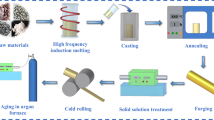Conclusions
-
1.
With rise in temperature the electrical resistivity of MgO/80% Ni-20% Cr cermets at first increases and then, after attaining a certain temperature (T∘max), begins to fall. The position of the maximum on the resistivity vs temperature curve is determined by the initial resistivity of the cermets and on the conductivity of their semiconducting phase; for cermets with resistivities of 1–20 Ω-cm, it lies in the range 350–100°C.
-
2.
The stability of the electrical resistivity of the cermets at elevated temperatures in air falls with increasing resistivity. Cermets with resistivities of the order of 1–10 Ω-cm are capable of operating for a long time in a stable manner in air as heating elements at temperatures of up to 250–300°C.
Similar content being viewed by others
Literature cited
S. P. Tolochko, A. A. Vecher, et al., “Variation of the electrical resistivity of materials of the Kh20N80-alloy-magnesia system with composition and method of preparation,” Poroshk. Metall., No. 7, 27–31 (1977).
V. T. Koftelev, “Limiting operating temperature of heating elements made of conducting cermets,” Poroshk. Metall., No. 12, 57–60 (1974).
P. Margineanu, A. Olaria, and E. Weissmann, “Electrical conductivity of nickel-alumina and nickel-chromia systems,” Rev. Roum. Phys.,13, No. 6, 549–558 (1968).
Crystallochemical, Physicochemical, and Physical Properties of Semiconductor Substances (A Handbook) [in Russian], Standartov, Moscow (1973).
V. T. Koftelev, S. I. Faifer, F. I. Busol, et al., “Sintered cathode heater technology,” Elektron. Tekh., Ser. 14, No. 6 (1969).
N. A. Mel'nikova, L. M. Pakchanin, and P. V. Petrenko, “Effect of oxidation on the residual electrical resistance of nickel-chromium alloys,” Republican Interdisciplinary Symposium on Metal Physics [in Russian], Vol. 57, Naukova Dumka, Kiev (1975), pp. 77–80.
B. L. Ositinskii and S. M. Vaisman, “Optimum conditions for the sintering of cermet electric heating elements,” Poroshk. Metall., No. 12, 20–25 (1976).
Author information
Authors and Affiliations
Additional information
Translated from Poroshkovaya Metallurgiya, No. 6(186), pp. 39–42, June, 1978.
The authors wish to thank S. S. Yashchuk and É. M. Shpilevskii for assistance with some tests.
Rights and permissions
About this article
Cite this article
Tolochko, S.P., Vecher, A.A. & Kononyuk, I.F. Variation of the electrical resistivity of sintered materials of the Ni-Cr-alloy/magnesia system with temperature. Powder Metall Met Ceram 17, 443–446 (1978). https://doi.org/10.1007/BF00795798
Received:
Issue Date:
DOI: https://doi.org/10.1007/BF00795798




